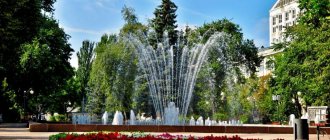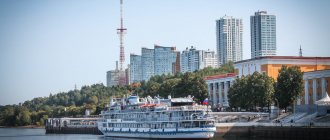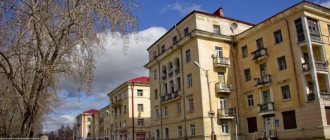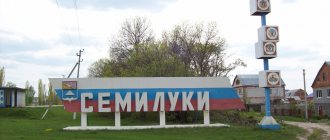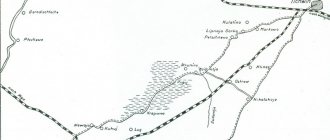Pudozh: areas, recreation, excursions, museums and churches, cuisine and restaurants, shopping and shops, attractions of Pudozh.
- Last minute tours
to Russia
Pudozh is the most exotic part of Karelia; most of the ancient rock paintings are located here. Pudozh has been known as a settlement since 1382; it is included in the list of the 200 oldest cities in Russia. In the central part of the city, residential blocks dating back to the 19th and early 20th centuries have been preserved. In the vicinity of the city there is Kashina Gora, a deposit of gray and pinkish-gray granite. The beautiful ensemble of the Ilyinsky churchyard and the Murom monastery have also been preserved.
Pudozh, a small northern town with wooden houses, front gardens and boardwalks along quiet streets, is one of the two hundred ancient cities of Russia and has had historical status since 1991.
The name comes from car. "puvas" - a branch of a river, channel. The city is located on the elevated bank of the Vodla River, 25 km from its confluence with Lake Onega, 197 km from the Medvezhya Gora railway station.
General information
Pudozh is located on the right bank of the Vodla River, 25 kilometers from its mouth.
This largely explains the origin of its name: translated from Vepsian “pudas” and Karelian “puvas” it sounds like an arm of a river or channel. But there is another equally popular theory: there is an opinion that the settlement received its name from the ancient Russian measure of scales, the word pud. This is not surprising, since in the Middle Ages the city was the main supplier of flax and honey products in the Novgorod province, which was largely facilitated by its favorable transport location. The settlement, home to more than 8.5 thousand people, is the administrative center of the Pudozh district. Its national composition is represented mainly by Karelians, Russians, Vepsians, Ukrainians and Belarusians.
Pudozh
(Republic of Karelia)
OKATO code:
86242501
Founded:
1382
City since:
1785 City of district subordination (Pudozh district of the Republic of Karelia)
Center:
Pudozh district
Telephone code (reference phone)
| 81452***** | — |
Deviation from Moscow time, hours:
0
Geographic latitude:
61°48′
Geographic longitude:
36°32′
Altitude above sea level, meters:
55 Sunrise and sunset times in the city of Pudozh
Story
The first mention of the settlement dates back to 1382. Until the middle of the 15th century, the settlement was part of the Zaonezhsky churchyards of the Novgorod region. Since 1478, the lands came under the control of the Russian state.
During the Time of Troubles, local territories were often subjected to armed attacks by Poles, but survived.
In the 18th century, by personal decree of Catherine the Great, Pudozh was appointed a district town of the Olonets governorship. After the abolition of the latter at the end of the 18th century, it was assigned to the Arkhangelsk province as part of the Onega district. After the restoration of the Olonets province at the beginning of the 19th century, Pudozh again became part of it with the status of a county town. At this time, the city industry was actively developing:
- Several glass factories started operating;
- enterprises for the production of linen products began to operate successfully, which subsequently glorified the region far beyond the borders of Russia (products made from Pudozh flax won awards at exhibitions in Paris, Brussels and Ghent);
- factories for harvesting and processing wood were opened, the products of which were supplied not only throughout Russia, but were also successfully exported. Their successor, the Pudozh Timber Mill, is still in operation today.
Since 1873, regular steamship service was established between Pudozh and Petrozavodsk. And almost 30 years later, the first telephone line appeared in the city.
The beginning of the 20th century was marked by a tense political situation for the city, which was accompanied by demonstrations, uprisings and rallies.
Since the middle of the 20th century, the Pudozh territories were included first in the Karelian Labor Commune, and then in the Karelian Autonomous Republic. At the same time and until 1943, the settlement was transferred to the status of a village.
In 1956, a small airport with one runway and an air terminal was built on the outskirts of Pudozh. As of today it is not working.
In 1991, the city was given historical status.
Pudozh, city. Karelia.
Pudozh is a little Paris , only the houses are lower and the asphalt is thinner. (from folk humor).
Pudozh is located on the right bank of the Vodla River, the administrative center of the Pudozh district. The name of the city Pudozh presumably comes from the Karelian word pudas , that is, a branch of a river, a channel. There is, however, an opinion that Pudoga (as the present Pudozh was once called) comes from the word pud and is associated either with the grain trade, or with the catch of one of the local fishermen, which is explained in the ethnographic information of the Olonets province for 1856 .
Pudoga is the oldest Novgorod settlement in Obonezhye; the first written mention of it is found in one of the Novgorod birch bark documents, dated 1382 . It was along the Vodla River that the trade route from Novgorod to the White Sea passed.
Being a remote outskirts, the lands of Pudozh became a place where Old Believers fled from persecution by the official Orthodox Church. Several large mass self-immolations of schismatics took place in these places.
Under Peter I, Pudozh residents were involved in public works for the construction of the new capital of the Russian Empire - St. Petersburg, due to which one of its streets is called “Pudozhskaya”.
According to the revision of 1782, in Pudozh and the villages there were only 515 male souls, including 376 burghers, 61 commoners and 71 merchants. There were 195 residential buildings and 3 government buildings. The poet G.R. Derzhavin, being the Olonets governor, visited Pudozh in the summer of 1785, that is, after Pudozh officially received the status of a city, he found only 50 houses and 120 inhabitants in it. In his travel notes, he gave them a funny description: “The inhabitants of Pudozh are affectionate, courteous and quite hardworking, but living at a distance from the government, they are self-willed and somewhat rude to their nearby bosses.”
Fairs were held annually in Pudozh: Nikolskaya in January and Trinity in June. Trade was mainly in fabrics and haberdashery. Merchants from Petrozavodsk, Olonets, Kargopol and Vytegra came to the fairs.
The main occupations of the Pudozhians were agriculture, cutting and rafting of timber, fishing and hunting. Pudozh pine was used in the construction of the Russian fleet. In the 19th century the ship's timber was towed by steamers to St. Petersburg.
In addition, a special source of income was the cultivation of flax, famous for its quality throughout Russia (the so-called “korelka” ). After processing, flax fiber acquired a unique silvery shine and was highly valued. Up to 40 thousand pounds of flax were exported annually to St. Petersburg, to the Shungov Fair, and abroad. In 1855, Pudozh flax was even presented at the “World Exhibition of Industry, Agriculture and Fine Arts” in Paris. proverb “There are only two cities in the world: Pudozh and Paris” appeared (supposedly this is what local merchants said when talking at home about foreign miracles).
By the beginning of the twentieth century, Pudozh was a typical merchant city, far from being one of the poorest. In 1902, the city already had its own telephone line.
In the city center, buildings from the late 19th century to the beginning of the 20th century have been preserved. House of the merchant of the 1st guild N.A. Bazegsky, Church of St. Alexander Nevsky (Pionerskaya St., 38). This brick church is in the Russian style, built in 1903 also at the expense of the merchant Bazegsky. During Soviet times, the building housed a creamery. Now the church has been returned to believers and is being restored.
Alexander Grigorievich Kostin (teacher, local historian, historian) published a book of Pudozh . In it he reflected the most different aspects of the life of Pudozh residents. In his book, Alexander Grigorievich Kostin writes: “For a long time, offensive nicknames have been assigned to Pudozh residents: “Pudozh burbots”, “robes”, “little fatheads”...
Modern Pudozh is a quiet Karelian town with a population of 9.5 thousand people, with wooden houses, front gardens and boardwalks along quiet streets. It is one of the two hundred ancient cities of Russia and has had historical status since 1991. Located 360 km from Petrozavodsk.
The article uses photos and materials from open sources.
Pudozh today
The most developed industries in the city are forestry and mining. Enterprises engaged in the extraction of granite and gabbro-diabase, the production of crushed stone, processing and logging successfully operate in Pudozh. Also in the village there is a large bakery, a modern dairy plant and an enterprise for the production of honey and honey products.
The real pride of Pudozh is its folk choir, which for 30 years has been glorifying the city far beyond the borders of Karelia.
Every December, the city hosts the “Winter Nikolskaya Fair”, accompanied by large-scale folk festivities. Guests of the fair can not only pick up gifts for themselves and their loved ones for the New Year, created by the hands of local craftsmen, but also try a traditional delicacy: burbot fish soup.
The educational urban environment is represented by the following institutions:
- 2 high schools;
- branch of Segezha Northern College;
- school of arts with music and art and graphic departments;
- children's and youth sports school.
City today
It is very thriving in tourism and culture.
24 students from grade 4 “A” and 24 from grades 4 to 9 at school and No. 3 are studying under the “Learning with Intel” program.
A very good, wonderful city. The city's residents love him. Everything is wonderful in Pudozh. There are many kind and helpful people in the city!
A wonderful children's playground was built on Lenin Street.
- Monument to the date of renaming the Pudozh churchyard into the district town of Pudozh
- Children's playground in front of City Hall
- Favorite alley of Pudozhans
- Panorama of the central part of the city
- Old house on an old street
- Mass graves
- Church of Seraphim of Sorov
- Building of the merchant Bazegsky
Must see
A walk through the city center will help you immerse yourself in the atmosphere of the 19th century; here, the historical buildings of that time have been preserved in their original form. Neat wooden houses with front gardens, narrow streets with paved sidewalks work better than a time machine and perfectly help you feel the atmosphere of that era. Here you can observe how not only wealthy merchants and government officials lived, but also townspeople with more modest incomes.
One of the main architectural attractions of the city is the house of the merchant Nikolai Bazegsky. Until the beginning of the 20th century, his mansion was the only stone residential building in Pudozh. And the merchant himself is to this day the most titled resident of the city. Today here you can get a closer look at the merchant life of the 19th-20th centuries.
A work of stone architecture, the Alexander Nevsky Church, built in 1903, deserves special attention. The temple is active.
To get acquainted in detail with the complex history of local lands, you should definitely visit the Pudozh Museum of Local Lore. The permanent exhibition shows the history of the region from ancient times to the beginning of the 20th century. More than 7 thousand unique exhibits have been prepared for museum guests, carefully collected by its founder, local historian and local historian Alexander Korablev.
You can honor the memory of the soldiers who defended the country from the fascist invaders by laying flowers at the memorial in their honor.
In the vicinity of Pudozh, on the coast of Lake Onega, unique rock carvings and petroglyphs were found, made by ancient people in the 2nd millennium BC. Tourists from all over the world come to see these bizarre Neolithic cave paintings with their own eyes.
Not far from Pudozh is the Vodlozersky National Park with unique monuments of wooden architecture, untouched taiga and a fabulous forest with incredibly rich flora and fauna.
Sights of the city of Pudozh
File:123 (1).jpg
The settlement of Ancient Pudoga appeared as a Russian settlement on one route from Novgorod to the White Sea region. From birch bark letter No. 131, found in Novgorod, we learn that in 1382 -1396. Pagan customs were still strong in the territory of Pudoga. The letter mentions the pagan holiday “about Rusalia,” which the Christian Church did not recognize. From another source, the book of Yu. Saburov, we learn that by the middle of the 15th century, the Pudozh Nikolsky churchyard was already the center of peasant life. It is known that the presence of a churchyard is mandatory for a churchyard center. There is a mention of Pudozh churches in a scribe’s book of 1563: “Summer of St. Nicholas the Wonderworker and warm in the name of the Life-Giving Trinity.” There is also a mention of five courts of clergy. The church settlement itself was not isolated. It served as the center of the surrounding villages. And around Pudozh there were up to 200 of them. Chapels were built in remote villages. In the village of Urzhakovo - Ilyinskaya, in the village of Sumazero - Zosima and Savvatia; 1582; According to N.A. Korablev, one of the churches - Nikolskaya (or its direct predecessor) was built and functioned back in Novgorod times, i.e. until the end of the 15th century. In Pudozh at different times there were: Trinity Church, St. Nicholas the Wonderworker (mentioned in 1600), Kazan Church, 1788. There were also chapels. The image of one of the last ones in the photograph, it was located in the center of the city and was the place of consecration of the spring driving of cattle to pastures and before the first grazing. Today, a church stall has been erected in memory of the chapel. At the junction of the ancient streets Troitskaya and Platonovskaya there was a wooden Trinity Church built in 1563. In its place, a stone cathedral was built in the 19th century. The Holy Trinity stone three-altar church was considered the main one in Pudozh. “Decent on the outside, splendid on the inside; built in 1817 with the diligence of parishioners, and in 1890 expanded at the expense of the merchant Bazegsky, at a cost of 14,000 rubles, with a stone bell tower and a gatehouse; fence on a stone foundation with an iron grating1.” The minister in the cathedral was Glazachev Platon Ivanovich, a dean who was repressed in the 30s of the 20th century. His descendants still live in the city. The church was destroyed in 1948. A worship cross was erected in memory of the temple. In 1903, the Church of the Holy Blessed Prince Alexander Nevsky was built (Pudozh, Pionerskaya Street (old Olginskaya), no. 38) on the site of an ancient graveyard, where a wooden church stood in the 17th century. The merchant Bazegsky offered Pudozhans a choice: either a bridge across the river. Vodla, or build a stone church. At that time, there was only a ferry crossing on the river, and people had great difficulty getting across the river in the summer. But the city residents decided to build a church with a bell tower. During Soviet times, there was a creamery in the church building. The domes and domes have been dismantled. Since 2007, the church has been opened and services have been held. At the same time, restoration work continues to restore the original appearance of the temple. The church is part of the courtyard of the Murom Monastery. There is a chapel on the territory of the monastery (pictured on the right), in which the main services were held before this became possible in the Church of Alexander Nevsky. In Pudozh, there is a parish church of St. Seraphim of Sorov, rebuilt from a simple house. At the expense of parishioners, the Church of the Quick Hearer is being built on a new, high place.
Article prepared by Natalia Vartiainen
How to get there
The settlement is located 352 kilometers from Petrozavodsk. Regular buses run here from the capital of Karelia, and you can also get to the historical city by boat, which departs from the Shala pier. Regular bus service has also been established with St. Petersburg and Vytegra. The federal highway A-119 “Vologda – Medvezhyegorsk” passes through Pudozh.
A visit to Pudozh will allow you to fully enjoy the peace and tranquility of the ancient northern provincial town, where every corner is saturated with history. Hospitable Pudozh always warmly welcomes its tourists.
